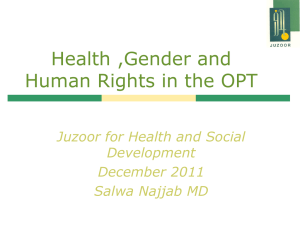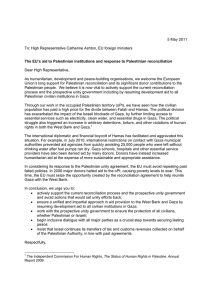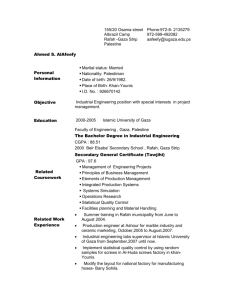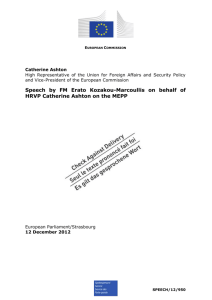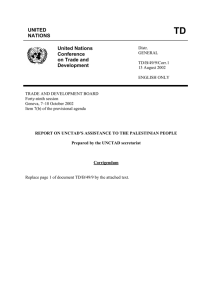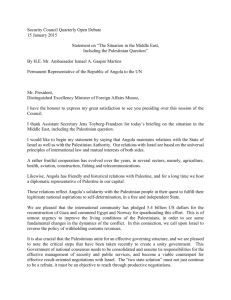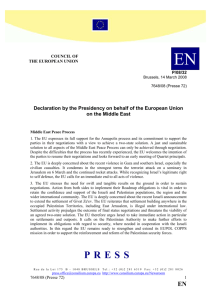The Palestinian economy: towards recovery and sustained growth UNCTAD
advertisement
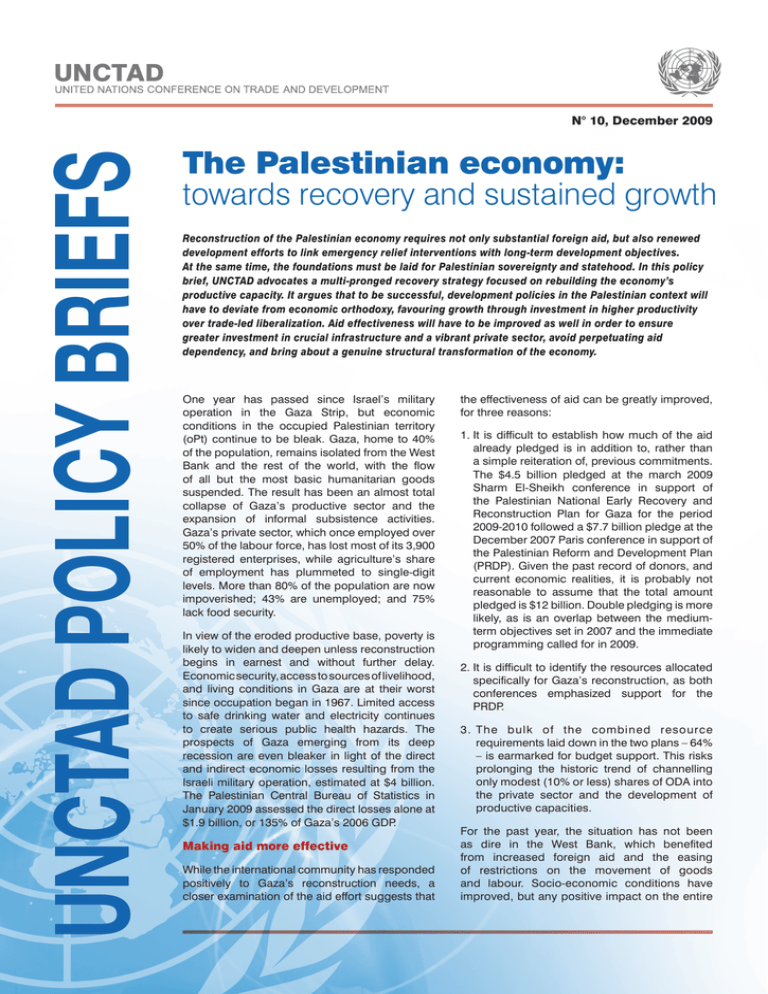
UNCTAD UNCTAD POLICY BRIEFS N° 10, December 2009 The Palestinian economy: towards recovery and sustained growth Reconstruction of the Palestinian economy requires not only substantial foreign aid, but also renewed development efforts to link emergency relief interventions with long-term development objectives. At the same time, the foundations must be laid for Palestinian sovereignty and statehood. In this policy brief, UNCTAD advocates a multi-pronged recovery strategy focused on rebuilding the economy’s productive capacity. It argues that to be successful, development policies in the Palestinian context will have to deviate from economic orthodoxy, favouring growth through investment in higher productivity over trade-led liberalization. Aid effectiveness will have to be improved as well in order to ensure greater investment in crucial infrastructure and a vibrant private sector, avoid perpetuating aid dependency, and bring about a genuine structural transformation of the economy. One year has passed since Israel’s military operation in the Gaza Strip, but economic conditions in the occupied Palestinian territory (oPt) continue to be bleak. Gaza, home to 40% of the population, remains isolated from the West Bank and the rest of the world, with the flow of all but the most basic humanitarian goods suspended. The result has been an almost total collapse of Gaza’s productive sector and the expansion of informal subsistence activities. Gaza’s private sector, which once employed over 50% of the labour force, has lost most of its 3,900 registered enterprises, while agriculture’s share of employment has plummeted to single-digit levels. More than 80% of the population are now impoverished; 43% are unemployed; and 75% lack food security. In view of the eroded productive base, poverty is likely to widen and deepen unless reconstruction begins in earnest and without further delay. Economic security, access to sources of livelihood, and living conditions in Gaza are at their worst since occupation began in 1967. Limited access to safe drinking water and electricity continues to create serious public health hazards. The prospects of Gaza emerging from its deep recession are even bleaker in light of the direct and indirect economic losses resulting from the Israeli military operation, estimated at $4 billion. The Palestinian Central Bureau of Statistics in January 2009 assessed the direct losses alone at $1.9 billion, or 135% of Gaza’s 2006 GDP. Making aid more effective While the international community has responded positively to Gaza’s reconstruction needs, a closer examination of the aid effort suggests that the effectiveness of aid can be greatly improved, for three reasons: 1. It is difficult to establish how much of the aid already pledged is in addition to, rather than a simple reiteration of, previous commitments. The $4.5 billion pledged at the march 2009 Sharm El-Sheikh conference in support of the Palestinian National Early Recovery and Reconstruction Plan for Gaza for the period 2009-2010 followed a $7.7 billion pledge at the December 2007 Paris conference in support of the Palestinian Reform and Development Plan (PRDP). Given the past record of donors, and current economic realities, it is probably not reasonable to assume that the total amount pledged is $12 billion. Double pledging is more likely, as is an overlap between the mediumterm objectives set in 2007 and the immediate programming called for in 2009. 2. It is difficult to identify the resources allocated specifically for Gaza’s reconstruction, as both conferences emphasized support for the PRDP. 3. T he bulk of the combined resource requirements laid down in the two plans – 64% – is earmarked for budget support. This risks prolonging the historic trend of channelling only modest (10% or less) shares of ODA into the private sector and the development of productive capacities. For the past year, the situation has not been as dire in the West Bank, which benefited from increased foreign aid and the easing of restrictions on the movement of goods and labour. Socio-economic conditions have improved, but any positive impact on the entire UNCTAD First, the impact of any aid channelled into rebuilding and reviving the economy of Gaza, and of the oPt as a whole, will be limited in the absence of a comprehensive development strategy – one that lays the productive and institutional foundations for a sovereign Palestinian State free of Israeli settlements and occupation. The PRDP calls for creating an enabling environment for private sectorled development, and stresses economic liberalization and trade-led development. However, a developmentdriven approach that targets the structural problems of the economy – particularly its weakened productivity – would be far more appropriate. Moreover, greater synergy is needed between the two reconstruction plans, beyond their stated emphasis on shared development goals. Second, as referred to above, there are concerns over the amount of aid being pledged and the speed of its disbursement. The issue of double pledging aside, the exact amount of aid to be channelled into each plan remains unclear – an ambiguity compounded by the fact that aid disbursements are in many cases contingent on political conditionality. Third, any lasting recovery will be difficult if not impossible to attain with the existing meagre levels of investment in productive capacity development – and given that the two reconstruction plans allocate far larger sums to budget support than to investment, any significant increase in those levels seems unlikely. But while budget support is obviously vital for enabling the Palestinian Authority (PA) to provide basic services and employment, it is also important that adequate resources are earmarked for investment in infrastructure projects and private sector development. Meeting development objectives For donor response to be effective, donors must realize that the constraints on the Palestinian economy in general, and Gaza in particular, are not just the results of recent confrontations but are rooted in prolonged occupation, protracted conflict and isolation. The combined effect of these factors has been the subjection of the economy, especially Gaza, to conditions reflecting a devastating and recurrent reversal of hard-won development gains. To master the challenges associated with these conditions, the aid effort should be geared towards meeting strategic national development objectives, linking them to the extent possible to humanitarian relief efforts. Rehabilitating basic infrastructures and revitalizing the private sector should be accorded priority treatment, and creative solutions should be found to ensuring greater predictability of aid flows. This would ease the pressure on the public sector, expand the tax base and reduce the dependence on public employment and government transfers as the main sources of livelihood. To this end, drawing on its 25 years’ experience in analysing the Palestinian economy, UNCTAD is advocating a multipronged strategy for sustained recovery, focusing on the following prerequisites for success: Revitalizing and expanding the eroded productive capacity, and investing in trade logistics. Re-establishing financial and trade links and facilitating trade flows between the oPt, Arab countries and the rest of the world. Restoring the severed commercial and production networks between Gaza and the West Bank. Failing this, not only will the two regions remain economically separated but they will diverge further, aggravating regional disparity and undermining the prospects for establishing the economic base required for a sovereign Palestinian State. Empowering Palestinian policymakers with a full range of related economic policy instruments. A new UNCTAD study* demonstrates that with such tools, GDP growth and employment opportunities would be far superior to those obtainable under the existing limited policy space. Reconsidering the existing economic and trade regime. Trade policy is just one policy tool, and its impact depends on the extent to which it is synergistically integrated with other policy tools to address the economy’s structural weaknesses. This policy rethinking needs to adhere to the multilateral trading system, but not as an end in itself. Rather, the focus should be on striking the best possible balance between compliance with WTO rules and the special needs of the Palestinian economy. In this context, supporting Palestine’s initiative to obtain observer status at the WTO acquires considerable importance. The exercise should also be seen as a contribution to reforming the economic institutions needed by the future State. Needless to say, no gains can be achieved without lifting the Gaza siege; removing the barriers to the internal and external movement of people and goods within, to and from the oPt; and creating an independent Palestinian State in accordance with the relevant UN resolutions. * UNCTAD (2008). Policy alternatives for Palestinian sustained development and state formation. UNCTAD/GDS/APP/2008/1. See also www.unctad.org/palestine. + 4 1 2 2 9 1 7 5 8 2 8 – u n c t a d p r e s s @ u n c t a d . o r g – w w w . u n c t a d . o r g unctad/press/PB/2009/5 Palestinian economy has yet to materialize. With internal trade and the movement of labour between the West Bank and Gaza blocked by the Gaza siege, the already wide gap in living conditions between the two regions is likely to expand further. Moreover, just how long the West Bank recovery can be sustained is uncertain, for three main reasons, above and beyond the lack of political progress:
